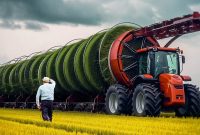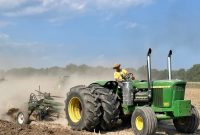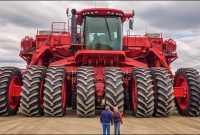In the realm of agriculture, a quiet revolution is taking place, one that is shaping the future of farming and food production. Tremendous advances in modern agricultural technology have begun to redefine the industry in ways previously unimaginable. This article explores the remarkable strides being made in agriculture through cutting-edge technology, and how these advances are changing the way we grow our food and address the global challenges of feeding a growing population.

The traditional image of agriculture as manual labor in vast fields, reliant on unpredictable weather and labor-intensive tasks, is being reshaped by modern agricultural technology. The key driver behind this transformation is innovation that harnesses the power of science, data, and automation to create more efficient and sustainable farming practices.

One area where these advances are most pronounced is precision agriculture. Modern farming equipment is now equipped with a host of sophisticated sensors, GPS technology, and data analytics tools. These tools allow farmers to monitor and manage their fields with unparalleled precision. Soil quality, moisture levels, and even crop health can be continuously assessed, helping farmers make informed decisions about when and where to plant, irrigate, and apply fertilizers or pesticides. This data-driven approach minimizes waste, optimizes resource usage, and results in higher crop yields.

The use of drones is another groundbreaking development in agriculture. These unmanned aerial vehicles can capture high-resolution images and multispectral data, providing farmers with valuable insights into the health of their crops. Drones can quickly identify areas affected by pests or disease, enabling prompt and targeted interventions. Moreover, they are essential for mapping fields, which helps farmers create more accurate planting and harvesting plans.

Artificial intelligence (AI) and machine learning are also contributing to the agricultural revolution. AI algorithms can analyze vast amounts of data to identify trends and patterns, helping farmers predict crop yields and optimize planting schedules. Machine learning is even used to develop autonomous vehicles, such as self-driving tractors, that can work tirelessly, day and night, to ensure efficient and timely field operations.

The integration of the Internet of Things (IoT) is yet another game-changer. With IoT, farmers can remotely monitor and control irrigation systems, adjust machinery settings, and receive real-time alerts about changing weather conditions or equipment malfunctions. This level of connectivity not only saves time and effort but also minimizes resource waste.

Sustainability is at the core of these advancements. Modern agricultural technology emphasizes eco-friendly practices. Efficient use of resources, reduced pesticide and fertilizer application, and optimized water usage contribute to a more sustainable agricultural model. Moreover, many innovations focus on reducing the environmental impact of farming, helping to protect natural ecosystems.
The global population is rapidly increasing, and the demand for food is growing. Modern agricultural technology offers a pathway to address these challenges. By increasing efficiency and reducing waste, it enables us to meet the demand for food without compromising environmental integrity. Moreover, it allows us to make agriculture more resilient in the face of climate change and other global challenges.
In conclusion, tremendous advances in modern agricultural technology are revolutionizing the way we grow our food. From precision agriculture to drones, AI, and IoT, these innovations are making farming more efficient, sustainable, and responsive to the needs of a growing world. As we continue to embrace these technologies, we are not only feeding our present but securing a more sustainable and productive future for generations to come.




